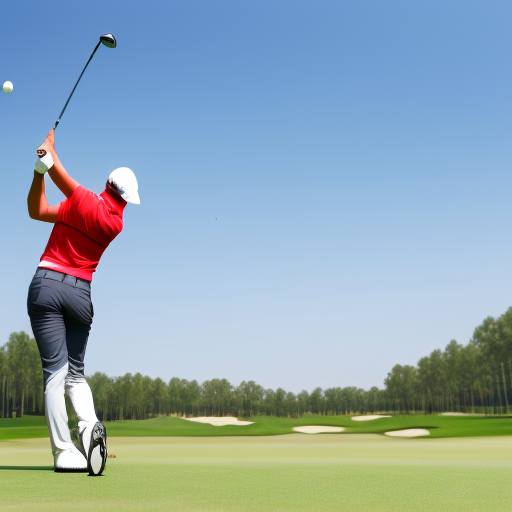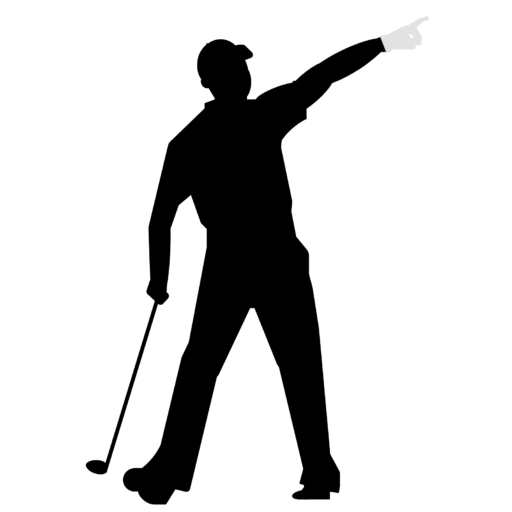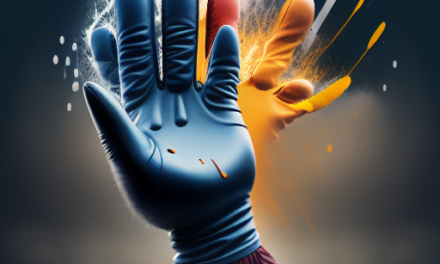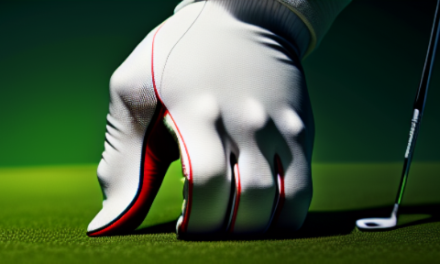
Are you tired of swinging for the fences, only to see your golf ball veer off course? You’re not alone. Slicing can frustrate even the most seasoned golfer. But don’t throw in the towel just yet. With some understanding of the mechanics, the right stance, grip, and swing adjustments, you can fix your slice. Welcome to the club of golfers who’ve battled the slice and won. It’s time to get your game back on track so you don’t embarrass yourself on the golf course.
Understanding the Basics of a Golf Slice
You’re about to delve into the basics of a golf slice, which can significantly impact your game if not corrected. A golf slice is a type of golf shot where the ball starts to the left of your target and curves dramatically to the right in the air, for a right-handed golfer. It’s a common issue for many amateur golfers, but understanding the basics of a golf slice is the first step to overcoming it and improving your golf handicap.
The key to mastering how to fix a slice lies in your golf swing and the position of your clubface at impact. If your clubface is open relative to the path of your swing, it imparts a rightward spin on the ball, causing it to slice. Your swing path also plays a role. If you’re swinging from outside to inside, it can exacerbate the slice.
Identifying the Causes and How to Fix a Slice
In identifying the causes of a slice in golf, you must consider both your swing path and club face position, but it’s also crucial to pay attention to your grip and stance. Your swing path refers to the direction your club is moving when it strikes the golf ball. If your path is moving left of the target line at impact, it’s likely causing your slicing. Meanwhile, an open clubface at the point of contact can also send the ball curving to the right.
To fix a golf slice, focus on these key areas:
- Clubface Position: Clubface position is crucial in fixing a slice. To ensure your club face is square to the target line at impact, follow these steps:
- Grip the club correctly: Start by having a proper grip on the club. Make sure your lead hand’s (left hand for right-handed golfers) knuckles are visible and the “V” formed by your thumb and forefinger points towards your rear shoulder. This helps place the club face in a square position.
- Align your club face: Before addressing the ball, position the club face, so it is square to the target line. This means the club should be perpendicular to the target line with no open or closed alignment.
- Maintain a square club face during your back swing: As you take the club back, focus on keeping the club face square to the target line. Avoid any excessive opening or closing of the club face, as this can affect your swing path and lead to slicing.
- Check your wrist position: At the top of your back swing, ensure that your lead wrist (left wrist for right-handed golfers) is flat or slightly bowed. This helps to keep the club face square throughout the swing.
- Lead with the club face on the downswing: As you start your downswing, actively lead with the club face. Try to square it up before impact by initiating the rotation of your wrists and forearms. This will help prevent an open club face at impact, which often results in a slice.
- Practice alignment drills: To reinforce a square club face position, incorporate alignment drills into your practice routine. Place alignment sticks or clubs on the ground to help guide you in aligning the club face correctly.
- By consistently practicing and focusing on maintaining a square club face at impact, you can improve your swing and reduce the likelihood of a slice.
- Golf Swing Path: Practice swinging your club on the correct path.
- In order to fix a slice, it is essential to work on your swing path. The incorrect swing path often causes the club face to open, resulting in a sliced shot. Here are some steps to practice swinging your club on the correct path:
- Understand the correct swing path: The ideal swing path for a right-handed golfer is an inside-to-out path. This means the club should approach the ball from inside the target line on the downswing, and then swing towards the target after impact. For left-handed golfers, the ideal path would be outside-to-in.
- Visualize the correct swing path: Before making your swing, visualize the correct swing path in your mind. Imagine drawing a line from behind the ball to the target and envision your club head following that line on the downswing.
- Develop a proper takeaway: A proper takeaway is crucial to getting on the correct swing path. During your takeaway, focus on keeping the club head inside the target line. Avoid taking the club too far outside on the back swing, as it can lead to an over-the-top swing and a slice.
- Use alignment aids: To practice swinging on the correct path, you can utilize alignment aids such as golf clubs or stakes placed on the ground. Position them parallel to your target line, representing the correct swing path, and practice swinging along this path.
- Swing on an inside-to-out path: When executing the downswing, aim to approach the ball from inside the target line. Focus on starting your downswing with your lower body, hips, and shoulders, while allowing your arms and hands to follow suit in a natural sequence.
- Avoid an over-the-top motion: One of the main causes of a slice is swinging over-the-top, where the club moves outside the target line on the downswing. To correct this, consciously emphasize starting the downswing with your lower body and feeling the club drop into the slot inside the target line.
- Record and analyze your swing: Utilize video recording to monitor your swing path. Observe whether your club is coming from the correct inside-to-out path or if there are any deviations causing the slice. Identifying the problem areas will help you make necessary adjustments.
- By practicing swinging your club on the correct path and focusing on an inside-to-out swing, you can improve the accuracy and minimize the occurrence of a slice.
- Grip: Adjust your grip to control the clubface better.
- Adjusting your grip is an important step in fixing a slice as it helps you better control the clubface. Here’s how you can adjust your grip to improve your clubface control:
- Check your hand placement: Start by evaluating the placement of your hands on the club. For right-handed golfers, the “V” formed by the thumb and forefinger of your lead hand (left hand for right-handed golfers) should point towards your rear shoulder. This helps position your hands in a neutral grip.
- Make grip adjustments: If you tend to slice the ball, you may need to make some grip adjustments as you may have a weak grip. One common adjustment is rotating your lead hand slightly more to the right (clockwise for right-handed golfers) This is called a strong grip. This helps promote a more closed clubface at impact, reducing the likelihood of a slice.
- Experiment with grip pressure: Pay attention to your grip pressure. Gripping the club too tightly can restrict your wrist movement, leading to an open clubface. Experiment with a slightly lighter grip pressure, allowing your wrists to hinge and release naturally through impact.
- Use an interlocking or overlapping grip: Consider using an interlocking or overlapping grip technique to promote better wrist action and control. These grips can help you maintain a more stable clubface throughout the swing.
- Practice with the adjusted grip: After making grip adjustments, spend time practicing with the new grip. Start with shorter swings and gradually work your way up to full swings. This process will help you get comfortable and familiarize yourself with the adjusted grip.
- Monitor the club face: As you practice, pay close attention to the position of the club face at different points of the swing. Ensure the club face is square to the target line at address, during theback swing, at the top, through the downswing, and at impact.
- By adjusting your grip to control the clubface better, you can improve your ability to square it at impact and reduce the occurrence of a slice. Remember, grip adjustments may feel unusual at first, but with practice, they can become more natural and help you achieve a more consistent, controlled swing.
- Stance: Stand with your feet, hips, and shoulders parallel to the target line.
- When it comes to fixing a slice, your stance plays a crucial role in promoting a proper swing path and club face position. Follow these steps to ensure your stance helps you correct a slice:
- Position your feet parallel to the target line: Start by placing your feet, so they are parallel to the target line. For right-handed golfers, this means your left foot should be slightly flared out towards the target with your right foot aligned parallel to it. This alignment encourages a more neutral swing path and prevents the tendency to swing across the target line, which can result in a slice.
- Align your hips with your feet: Once your feet are set parallel to the target line, make sure your hips are aligned with your feet. When your hips are properly aligned, they’ll facilitate a more natural and on-plane swing. Avoid allowing your hips to open up towards the target, as this can lead to an open club face and a slice.
- Square your shoulders to the target line: Next, square your shoulders to the target line. Aligning your shoulders correctly promotes proper body rotation during the swing and helps maintain a square club face at impact. Ensure your lead shoulder (left shoulder for right-handed golfers) is slightly lower than your trail shoulder, producing a slight tilt in the upper body.
- Maintain proper distance and width: For a consistent swing, maintain a proper distance between your feet that aligns with your shoulder width. This allows for a stable base and balanced weight distribution throughout the swing. Avoid an overly wide or narrow stance, as it can affect your ability to rotate and transfer weight effectively.
- Visualize and use alignment aids: To help with stance alignment, visualize a straight line extending from your feet, through your hips, and up to your shoulders parallel to the target line. You can also use alignment aids such as alignment sticks or clubs placed on the ground to validate your stance and ensure it is aligned correctly.
- By standing with your feet, hips, and shoulders parallel to the target line, you establish a more solid foundation for your swing, promote a proper swing path, and enhance your ability to square the clubface at impact. Combined with other corrective measures, adjusting your stance can contribute significantly to fixing a slice.
Importance of Proper Stance and Grip
Mastering a proper grip and stance, you’ll find it much easier to control your swing and strike the ball accurately. The golf grip is your only physical connection to the club, and it’s crucial for dictating the club face’s orientation at impact. For a right handed golfer, the left hand should be at the top of the grip, with the thumb pointing down the shaft, and the right hand should mirror this position below.
A slice, one of those pesky errors that can creep into your game, often results from an improper grip. If your hold on the club is too weak, the club face will open, sending the ball off to the right. Adjusting your golf grip so it’s stronger can help rectify this.
Your stance is equally vital. A proper stance is the foundation of a good swing. Feet should be shoulder width apart, with the ball positioned so it’s in line with the inside of your left heel. Align your body parallel to your target line. This allows your swing path to work inwards, preventing an open club face at impact, and reducing the risk of slicing. Welcome to the community of golfers who understand the importance of these basics.
Correcting Your Swing Path and Plane
Let’s delve into adjusting your swing path and plane, because they’re key to hitting the ball straight and true. As a golfer, you’re part of an elite community that values precision and technique, and correcting your swing is an essential step in your journey to mastery.
Your swing path is the direction your club travels to hit the ball. If it’s too far inside or outside, you’ll likely end up with a slice. The club path, on the other hand, is the direction your club is pointing at impact. To correct slices, you’ll need to adjust both of these elements.
Here are some steps to help you:
- Practice your swing without a ball, focusing on a smooth, straight path.
- Adjust your grip, making sure your hands are in the correct position.
- Try to keep the clubface square at impact, aiming for a neutral club path.
- Finally, work on maintaining a consistent plane, the angle of your club as you swing.
Making Adjustments to Your Club face Position to Fix a Slice
You’re now ready to adjust your clubface position, and it’s crucial to remember that the position at impact greatly affects the direction of your shot. If you’re struggling with a slice, the culprit might be an open club face. This position at impact sends the ball veering to the right.
Let’s delve into the technicalities. Your clubface must be square to the target line at impact. Any deviation from the square clubface sends the ball off course. An open club face, where the club head is angled right of the target line, will result in that dreaded slice. So, it’s time to make some crucial adjustments.
Start by ensuring you’re holding the club correctly. Your left hand’s knuckles should face the target, and the V shape between your thumb and index finger should point towards your right shoulder. This grip will help you maintain a square clubface during your swing.
Next, focus on the club head during your backswing and downswing. It must stay square to the swing path, not the target line. By practicing these adjustments, you’ll soon conquer that slice, and feel a deeper sense of belonging in the golfing community.
Practice Drills for Overcoming a Slice
After adjusting your clubface position, you’ll need to work on some practice drills to help solidify your new swing mechanics and further combat your slice. These drills are designed to fix the dreaded slice that’s been plaguing your golf shots. You’re not alone in this journey, and you’ll soon feel a sense of belonging as you join many other golfers who have successfully eliminated this swing flaw.
To get started, consider the following drills:
- The Split Grip Drill: This drill helps you feel the correct clubface position at impact, fixing your right hand dominance.
- The Ball Position Drill: By moving the ball back in your stance, you’ll encourage a more in-to-out swing path.
- The Clubhead Cover Drill: This drill promotes an in-to-out swing path, further reducing the chance of hitting a slice.
- The Towel Drill: Placing a towel under your right armpit encourages a connected swing, which often helps in overcoming a slice.
Utilizing Golf Equipment to Combat a Slice
In addition to practice drills, you can also use specific golf equipment to tackle your slice, but it’s essential to remember that equipment alone won’t solve the problem. Your golf club, for instance, can play a crucial role in correcting your swing. Opt for a club with a flexible shaft, as it’s more forgiving and can help straighten your ball flight.
Take note of your grip as well. A stronger grip, where your hands are more to the right on the club (for right-handed players), can help you keep the clubface square at impact, reducing the likelihood of a slice. It’s a subtle shift, but it can make a world of difference to your swing and ball flight.
Conclusion
In mastering golf, conquering a slice is paramount. Your stance, grip, swing path, and clubface position all intertwine, dictating your slice or its absence. Through diligent practice, tactical equipment use, and keen understanding, you can recalibrate your swing. No longer will your ball veer right, but instead, fly straight towards victory. In golf, as in life, it’s not about eradicating flaws, but mastering them. So, step up, grip tight, and swing away. Your best game awaits.




